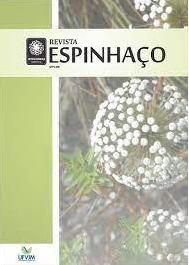Flowering temporality in dry and wet grasslands from the Chapada do Couto plateau in the Southern Espinhaço Mountain range-MG, Brazil
DOI:
https://doi.org/10.5281/zenodo.7810587Keywords:
Phenology, Rupestrian Fields, Pollination, Espinhaço Biosphere ReserveAbstract
The Southern Espinhaço mountain range harbors enormous biodiversity, with a vegetation typically dominated by grassland formations (campos rupestres and campos limpos) speckled with forest formations (capões de mata). This study aimed to evaluate the flowering temporality in areas of dry and wet (where peatlands occur) campos limpos, in order to highlight the temporal variation in plant reproductive characteristics (flower collor) and the effect of anthropization. Some of the studied sites were protected by the Rio Preto State Park, a nature conservation site of full protection, whereas the other sites were adjacent, but outside the conservation unit and subject to anthropization by grazing and fires. The sites were monthly evaluated for collecting botanical material and registering flowering species, being placed in six color categories (white, yellow, orange, red, pink/purple and blue). The protected area presented higher species richness (96) than the unprotected sites (83), although sampling stability was not reached in the collector curves. Most species presented annual flowering events, with more than half of the species being observed in a single month, concentrated in the rainy season, indicating an annual “flowering season”. White was the dominant collor (especially in Asteraceae and Eriocaulaceae), followed by pink/purple (Melastomataceae) and yellow (Asteraceae and Xyridaceae). While the collors associated with generalist pollinators (white and yellow) presented a markedly seasonal flowering, the flowers associated to more specialized systems (red and orange) apparently presented a more continuous flowering over time.
References
Almeida-Abreu, P.A., Fraga, L.M., Neves, S. (2005). Geologia. In: Silva, A.C., Pedreira, L.C.V.S.F., Abreu, P.A. (Eds). Serra do Espinhaço Meridional: paisagens e ambientes. Belo Horizonte: O lutador, p.17–44.
APG, Angiosperm Phylogeny Group (2016). An update of the Angiosperm Phylogeny Group classification for the orders and families of flowering plants: APG IV. Botanical Journal of the Linnean Society, 181(1), p. 1-20.
Bawa, K.S. (1990). Plant-pollinator interactions in tropical rain forests. Annual Review of Ecology, Evolution, and Systematics, 21, p 399-422.
Endress, P. K. (1994). Diversity and evolutionary biology of tropical flowers. New York: Cambridge University Press. 511p.
Giulietti, A.M., Pirani, J.R., Harley, R.M. (1997). Espinhaço Range region, Eastern Brazil. In: Davis, S.D.; Heywood, V.H.; Herrera-MacBryde, O., Villa-Lobos, J., Hamilton, A.C. (Eds). Centres of plant diversity: a guide and strategy for their conservation, v. 3: The Americas. Cambridge: WWF/IUCN Publications Unity. 562 p.
Gonzaga, A.P.D., Machado, E.L.M. (2021). Paisagens e vegetação da região do Espinhaço Meridional. Regnellea Scientia, 7, p. 162-186.
Lunau, K.; Papiorek, S.G. N.; Eltz, T, Sazima, M. (2011). Avoidance of achromatic colours by bees provides a private niche for hummingbirds. The Journal of Experimental Biology, 214, p. 1607-1612.
Maglianesi, M.A. et. al. (2020). High levels of phenological asynchrony between specialized pollinators and plants with short flowering phases. Ecology, 101(11), p. 1-9.
Martins, F. Q., Batalha, M. A. (2006). Pollination systems and floral traits in Cerrado woody species of the Upper Taquari region (central Brazil). Brazilian Journal of Biology, 66(2a), p. 543–552.
Maruyama, P.K.; Oliveira, G.M.; Ferreira, C. et al. (2013). Pollination syndromes ignored: importance of non-ornithophilous flowers to Neotropical savanna hummingbirds. Naturwissenschaften, 100, p. 1061–1068.
McGimpsey, V.J. e Lord, J.M. (2015). Flower Colour Change in Alpine Euphrasia. Austral Ecology, 40, p. 701-708.
Mendonça Filho, C. V., Costa, F. N., Machado, E. L. M., Gonzaga, A. P., Lourenço, A. P., Oliveira, C. N. S., Moura, C. C., Fonseca, S. N., Costa, T. R., Rech, A. R. (2022) Biodiversidade. In: Silva, A. C., Rech, A. R., Tassinari, D. (org.). Turfeiras da Serra do Espinhaço Meridional: serviços ecossistêmicos, interações bióticas e paleoambientes. Curitiba: Appris Editora. p. 81-106.
Moreira, M.M., Freitas, L. (2020). Review of the Pollination System by Small Diverse Insects. Neotropical Entomology, 49(4), p. 472-481.
Mori, A. M.; Silva, L. A. M.; Lisboa, G., Coradin, L. (1989). Manual de manejo do herbário fanerogâmico. Ilhéus: Centro de Pesquisas do Cacau. 97 p.
Muchhala, N.; Johnsen, S., Smith, S.D. (2014). Competition for hummingbird pollination shapes flower color variation in Andean Solanaceae. Evolution, 68(8), p. 2275–2286.
Reginato, M., Michelangeli, F. A. (2016). Diversity and constraints in the floral morphological evolution of Leandra s.str. (Melastomataceae). Annals of botany, 118(3), p. 445–458.
Renner, S. S. (1989). A Survey of Reproductive Biology in Neotropical Melastomataceae and Memecylaceae. Annals of the Missouri Botanical Garden, 76(2), p. 496–518.
Robroek, B.J.M., Jassey, V.E.J., Payne, R.J. et al. (2017). Taxonomic and functional turnover are decoupled in European peat bogs. Nature Communications, 8, p. 1161.
Silberbauer-Gottsberger, I., Gottsberger, G., (1988). A polinização de plantas do cerrado. Revista Brasileira de Biologia, 48, p. 651-663.
Silva, A. C., Rech, A. R., Tassinari, D. (2022). Turfeiras da Serra do Espinhaço Meridional: serviços ecossistêmicos, interações bióticas e paleoambientes. Curitiba: Appris Editora. 155 p.
Silveira, F.A., Negreiros, D., Barbosa, N.P., Buisson, E., Carmo, F.F., Carstensen, D.W., Garcia, Q.S. (2016). Ecology and evolution of plant diversity in the endangered campo rupestre: a neglected conservation priority. Plant and Soil, 403, p. 129-152.
Steenvoorden, J.; Limpens; Crowley, W. & Schouten, M.G.C. (2022). There and back again: Forty years of change in vegetation patterns in Irish peatlands. Ecological Indicators, 145, 109731.
Velloso, M. de S. C., Brito, V. L. G. de ., Caetano, A. P. S., Romero, R.. (2018). Anther specializations related to the division of labor in Microlicia cordata (Spreng.) Cham. (Melastomataceae). Acta Botanica Brasilica, 32(3), p. 349–358.
Versiane, A. F. A.; Romero, R.; Reginato, M.; Welker, C. A. D.; Michelangeli, F. A., Goldenberg, R. (2021) Phylogenetic analysis of Microlicieae (Melastomataceae), with emphasis on the re-circumscription of the large genus Microlicia. Botanical Journal of the Linnean Society, 197 (1), p. 35–60.
Downloads
Published
How to Cite
Issue
Section
License
Copyright (c) 2023 Revista Espinhaço

This work is licensed under a Creative Commons Attribution-NonCommercial-NoDerivatives 4.0 International License.


